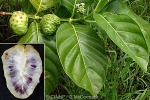Cook Islands Biodiversity Database
Species Page
Morinda citrifolia
NonoIndian Mulberry
Multimedia & Additional Resources
| Type | Description | Download |
| Leaves, flowers and fruit | 82KB |
General Information
Cook Islands Distribution
| Southern Group: Present Makatea: Present | ||||||||
RR |
MG |
AT |
MK |
MT |
AK |
PL |
TK |
MN |
++++ |
++++ |
++++ |
++++ |
++++ |
+++ |
P |
P |
?++W |
| Northern Group: Present | |||||
TN |
MH |
RK |
PK |
NS |
SW |
++++ |
P |
++? |
++++ |
++? |
P |
Scientific Taxonomy
Morinda citrifolia Linnaeus
SYNONYMS: Morinda citrifolia var. citrifolia
TAXONOMY: PLANTAE; ANTHOPHYTA (=Angiospermae); MAGNOLIOPSIDA (=Dicotyledones); ASTERIDAE; Rubiales; RUBIACEAE
More Information
IDENTIFICATION: Shrub to 6m. BRANCHES 4-angled. LEAVES along the branches, opposite, large, to 40x20cm, glossy, green; stipules round to 2cmØ; stalk short, to 2cm. FLOWERS a stalked sphere with a few open flowers, eventually totally 70-100; lobes 5, white, 7mm. FRUIT (a syncarp of fused flower-bases) ovoid, to 9x6cm, 70-100 ~5-sided sectors with central circle, yellow-white, ripens translucent grey, pungent. SEEDS 4-per-sector in translucent flesh, narrow-ovoid, to 9x4mm, very hard, large air-cell, float in water. cv 'Potteri' leaves mottled white, from Fiji, now elsewhere in Polynesia (not known in Cook Islands at present).
GENERAL NOTE: On Mangaia is was present in the oldest pollen samples dated at 7,300 years B.P. [Ellison 1994].
Yellow dye from roots and red dye from the bark in Fiji [ACSmith Flora] and also in Hawaii [Wagner et.al.].
Vouchers & References
Vouchers:
Pukapuka: fieldspecimen, 2/2004, G.McCormack with ID as Morinda citrifolia.
References:
p.1157 Wagner et al.- Flowering Plants of Hawaii
p.804 Neal - In Gardens of Hawaii
p.742 Hortus 3rd
p.757 Royal Hort. Soc. Index of Garden Plants
p.862 Tropica
p.4/334 A.C.Smith - Flora Vitiensis Nova
p.283 I Cheeseman - Flora of Rarotonga
p.102 Wilder - Flora of Rarotonga
p.383d Whistler - Ethnobotany of the Cook Islands
Data Update History (information):
zTX, zB02, zM02, zupM03a, zD02
Web Resources
Citation Information
McCormack, Gerald (2007) Cook Islands Biodiversity Database, Version 2007.2. Cook Islands Natural Heritage Trust, Rarotonga. Online at http://cookislands.bishopmuseum.org. ![]()
Please refer to our use policy.

